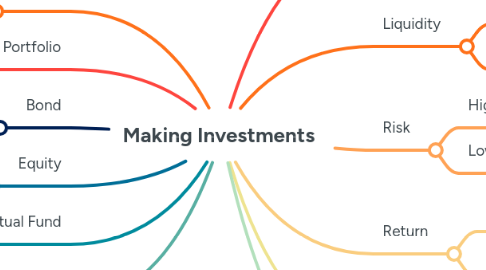Making Investments
by Maya Henstra


1. Stock
1.1. Buying a piece of a company (typically high risk)
2. Portfolio
2.1. Collection of investments like stocks, bonds, mutual funds, etc.
3. Bond
3.1. loans to corporations or government paid back with interest (typically low risk)
4. Equity
4.1. The value of an ownership interest in a company or property
5. Mutual Fund
5.1. Mix of different investments like stocks or bonds
6. Dividend
6.1. Your share of a company’s profits (money you may receive when company turns a profit)
7. Interest
7.1. Simple Interest
7.1.1. Interest only charged on principal
7.2. Compounding Interest
7.2.1. Interest charged based on initial principal and accumulated interest
8. Liquidity
8.1. Low Liquidity
8.1.1. Can’t be easily sold or converted to cash without substantial loss in value
8.2. High Liquidity
8.2.1. Can be easily and quickly bought or sold without substantial loss in value
9. Risk
9.1. High Risk
9.1.1. When there’s a high chance of losing all or substantial portion of the principal (typically higher return)
9.2. Low Risk
9.2.1. When theres a low chance of losing principal, often stable (typically low return)
10. Return
10.1. High Return
10.1.1. Have the potential to bring in a lot of profit (typically high risk)
10.2. Low Return
10.2.1. Have low payoff (typically low risk)
